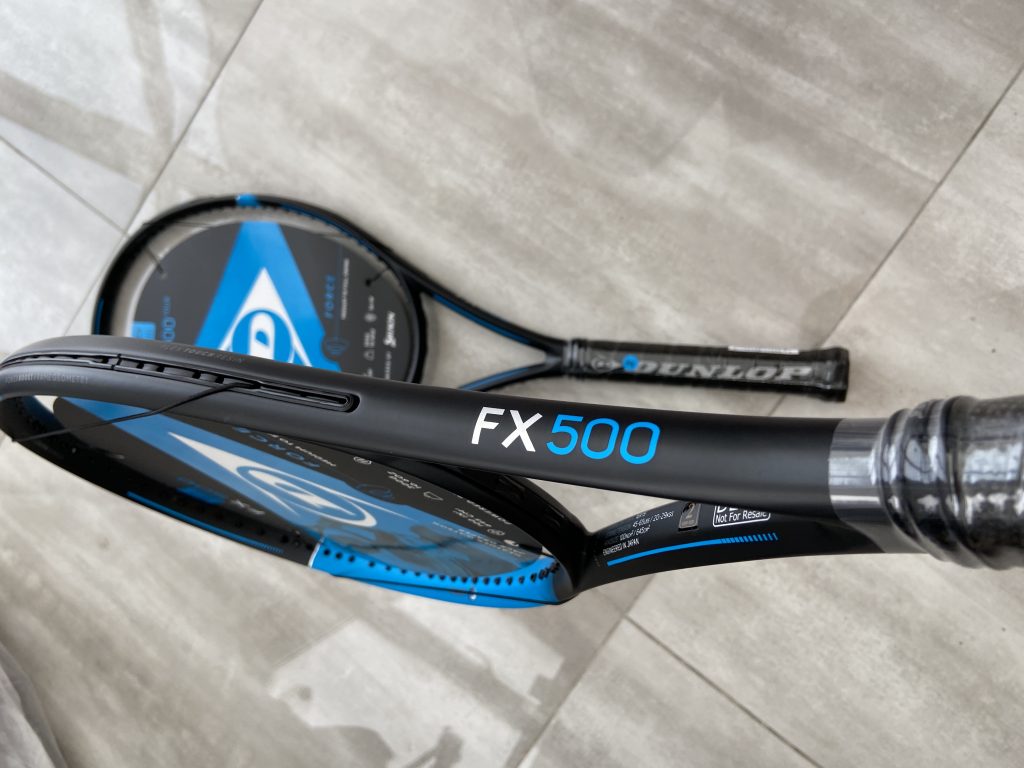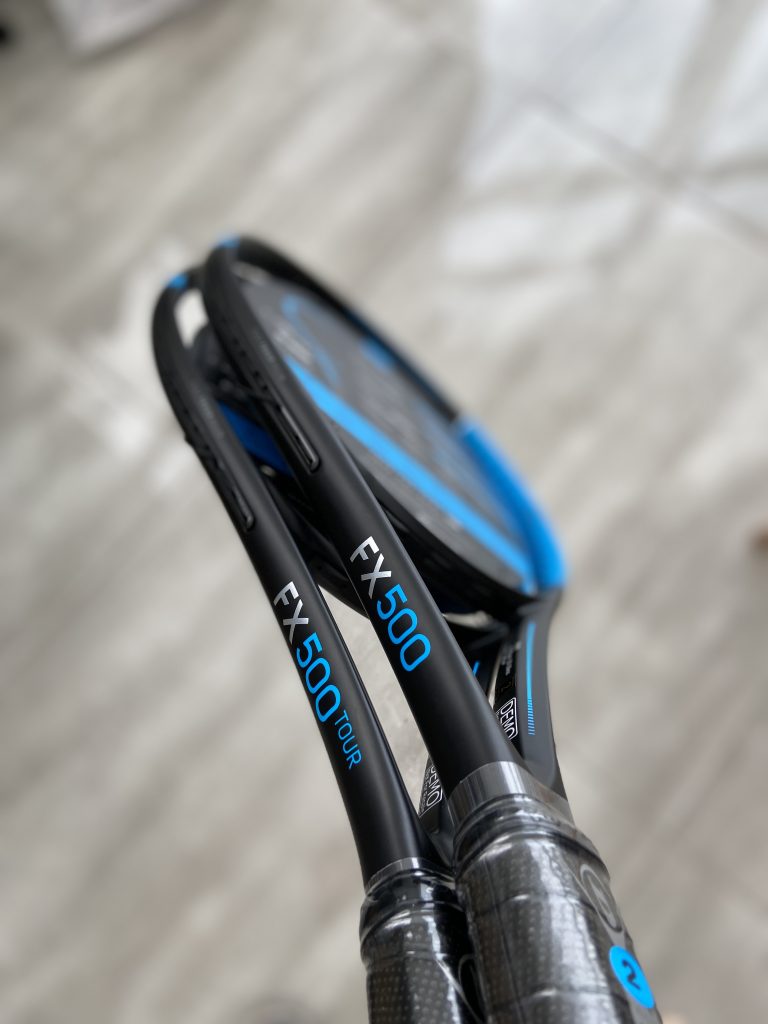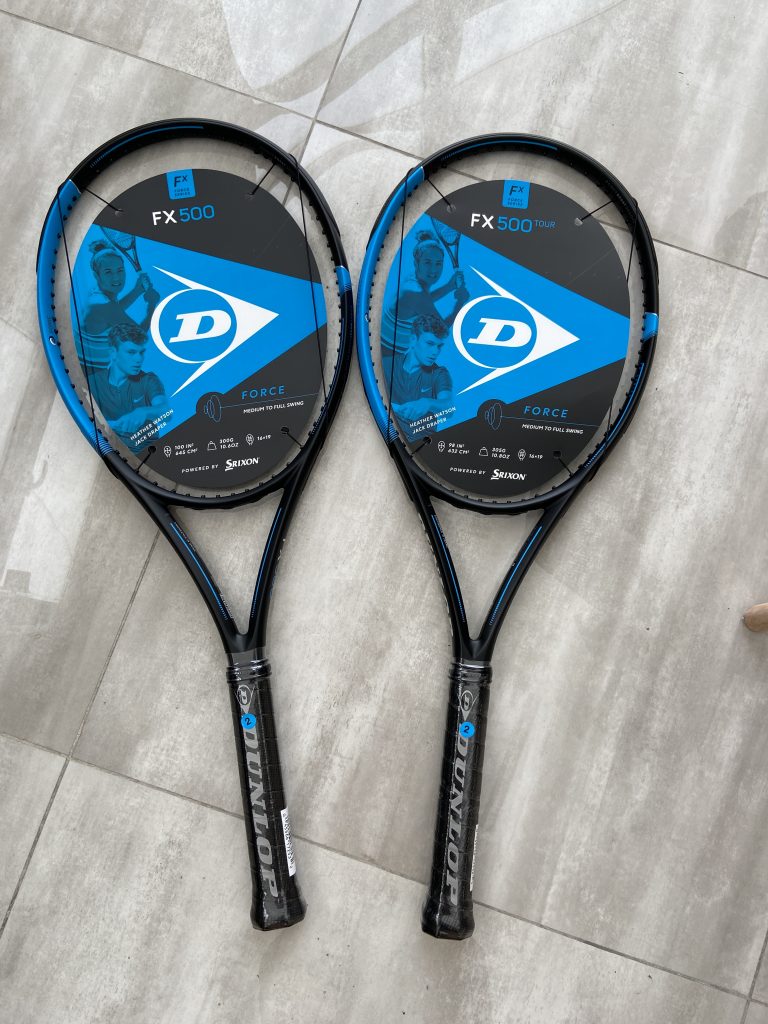It’s time for Dunlop to release their third line in their “element series”. F stands for Force and this is my Dunlop FX 500 Racquet review.
The Dunlop FX series is all about power as I wrote about in my preview post. I have appreciated all the recent Dunlop releases, from the CX 200 Tours, to the SX line which is more focused on spin. The FX line is all about power or “force” as Dunlop calls it. When we talk about power in tennis it generally means a thicker beam and a higher stiffness (close or above 70 RA) and this is what we get with the Dunlop FX series. In this Dunlop FX 500 racquet review, I deal with the Dunlop FX 500 and the Dunlop FX 500 Tour.
The racquets come with Power Boost Groove for an increased sweet spot and up to 5% more power. Flex Touch Resin for enhanced racquet feel and comfort, and Power Boost Geometry for increased frame stiffness and more control (20% wider throat)
Let’s start with the Dunlop FX 500.
Dunlop FX 500 Review

The Dunlop FX 500 is the “Pure Drive” of the FX line. It has a bigger sweet spot and lighter weight than the Tour version.
Dunlop FX 500
Head size: 100 sq inches
Length: Standard (68.6 cm or 27 in)
String Pattern: 16×19
Unstrung Weight: 300g
Balance: 32 cm (7 pts HL)
Beam: 23/26/23 mm
Stiffness: 71 unstrung (stiff)
I strung it up with Dunlop Explosive Speed at 55 lbs, a new softer poly that is paired with the FX line. I like the idea to release a string with the racquet, it makes it easier for players to find a good combo because the string market is even more confusing than the racquet market at times. The string played really nicely in the frame, soft for the arm but with good control.
The strung specs were: 318.5g, 32.3 cm, 310.5 SW (!). This includes a Dunlop overgrip as well. Generally, this type of frame should have a swing weight of around 320 in my opinion, but it still played pretty well at this low spec. It’s definitely a whippy racquet and it’s very easy to get racquet head speed. It also has a crisp feel that is muted, but not overly so.
How does the Dunlop FX 500 play?
After testing it in stock form, I tried adding a few grams of weight to the 12 o’clock position to bump up the swing weight, plow-through, and stability and that really helped the performance of the frame. I enjoyed the fast feel, the easy power, and the large sweet spot. This racquet reminded me of the Diadem FS Nova, it just felt fun and easy to use. If you’re on your game, you can really hit winners left, right, and center with this racquet, but the power can be difficult to control at times for players with big swings.
I normally gravitate towards more “Tour”-style racquets, but I actually preferred the playability of this one over the Tour version (I will get to that in my Tour review below).
My favorite areas with this frame were serving (easy to get pop and swing through) and volleys (maneuverable yet stable). This is a game improvement frame that I think anyone from 3.0 up to 4.5 NTRP can enjoy. I did not sense any discomfort from the stiffness, although if you have a sensitive elbow or wrist, I generally recommend you to go for a softer frame. But the dampening definitely seems to work in the Dunlop racquets.
Pros and cons
+ Easy power
+ Tight in the middle for directional control on flatter shots
+ Good dampening
+ Impressive maneuverability
– Too much power for the wrong player
– Quality control around swing weight needs work
– Needed a bit of extra weight for better plow-through and stability
Dunlop FX 500 Tour
Head size: 98 sq inches
Length: Standard (68.6 cm or 27 in)
String Pattern: 16×19
Unstrung Weight: 305g / 10.8 ounces
Balance: 31.5 cm (9 pts HL)
Beam: 21/23/22 mm
Stiffness: 70 unstrung (stiff)
I strung up the Dunlop FX 500 Tour with the same Dunlop Explosive Speed but at a slightly lower tension (54 lbs or 24 kg). I put it on my HEAD 3-in-1 machine and got the following specs: 324g, 31.6 cm, and 301 SW (!!). This is including overgrip.
A swing weight of 301 strung is not exactly a Tour spec and a sign of quality control issues. This is not unheard of. I have measured poor swing weight QC from Wilson, Babolat, HEAD, and Dunlop before. I once had a Clash 98 with a strung swing weight of 304.5 for example. Still, this has to be outside the range of what is acceptable when it comes to quality control. But the manufacturers don’t really promise anything when it comes to the swing weight, just the weight and balance. I just don’t think this is good enough. Most players can’t/won’t measure swing weight and probably won’t understand why a racquet feels too heavy or too light on the court. I think we need to see a swing weight QC tolerance as well.
How does Dunlop FX 500 Tour play?
In stock form, with the 301 SW, I found the Dunlop Tour too light and unstable. It suffered from similar issues to the Babolat Pure Drive VS. I find that a Tour racquet should come in at around 310-315g unstrung and a 325-330 strung swing weight. Otherwise, it’s not really Tour. The Dunlop FX 500 Tour suffers from a lack of weight in the head, it’s simply too head-light for a 98 sq inch racquet. If you look at the Ezone 98 or the Blade 98 or TF40, they have more weight towards the head and that is how they can remain stable at 305g unstrung.
Luckily, I have a roll of lead tape and a swing weight machine. So I added 3 grams at 12 o’clock and a dampener to get the specs up to 330g, 32 cm balance and 317 SW. The racquet became a lot more stable and enjoyable. It offered the same easy playability as the FX 500, but a bit more control due to the smaller head size and lower stiffness. For my game, I would probably add a few more grams at 3 and 9 (and some weight under the grip to counterbalance) to get the SW up to 325-330. But it was nice also in a lighter spec.
If you like a lighter, maneuverable, powerful, but not all the way to the 100 sq inch tweener-style powerful, this racquet is interesting. I think it is comparable to a Yonex Ezone 98. They are all about being fast and powerful. I prefer a bit more weight for volleys and a bit lower stiffness for control when it comes to Tour-style racquets. So although the FX 500 Tour is less powerful than the 500, I prefer the 500 as it just feels more naturally stable, has a slightly bigger sweet spot and the power levels are not that different.
I got an under spec Dunlop FX 500 Tour. It was nothing that a little lead tape couldn’t fix, but it makes the reviewing a bit more difficult. I know that most tennis players just buy a racquet and play with it. They don’t spend time adding weight and measuring, experimenting, etc like proper tennis nerds. It’s completely understandable because the path of nerdhood is a slippery slope. You can easily get lost in the jungle of tennis gear and customization. So I wish that the QC for all these mainstream tennis brands was better. Yonex seems to do it well (as well as smaller, direct-to-consumer brands like Angell), so why not the rest?
Summary
I like the Dunlop FX 500 racquets. Yes, they come in under spec, but still played nicely. I preferred the FX 500 for the raw power with good directional control. It was especially good for hitting flat winners. Thanks to the low weight and maneuverability I could really swing hard and get good racquet head speed. I also felt like the dampening materials worked. I sensed no discomfort, but I still felt connected to the ball (so not too muted).
Still, if you are looking for control and feel, this is not the category of racquets for you. These frames are easy to use, packed with pace, and for players who need or want some free stuff from the racquet. I had a lot of fun with them when I was on my game but lacked a little control at times when I needed to finesse the ball. This is normal for this style of a racquet, so nothing to complain about there.
If you are a fan of racquets like the Babolat Pure Drive or the Wilson Ultra 100, the Dunlop FX 500 is a must demo. I haven’t tried the new Pure Drive yet, but I think the FX 500 competes very well with that one. In the end, it’s a matter of the feel you prefer.
When it comes to the Dunlop FX 500 Tour it was disappointing to see it so under spec. It needs more weight to be a proper Tour racquet. Now it competes well with the Pure Drive VS, the new Yonex Ezone, or the HEAD Graphene 360+ Extreme Tour, but I personally prefer a bit more control like a Wilson Blade 98 or Tecnifibre TF40.
But if you want a fast-swinging powerhouse of a racquet, the Dunlop FX 500 racquets hold their own.
Have you tried the Dunlop FX 500 racquets?



















‘The path to nerdness is very slippery’ LOL, so true!
Hence, I have to ask did you weigh the frames before you strung them, and did you weigh the string iteself? If the rackets were on spec unstrung, and your overgrips weigh about 6g, then the Dunlop Explosive you used would have been around 12-13g per frame, which is a relatively light string. With a heavier string, it could be akin to adding 6g at 3&9, which according to TW would add about 10pts to the swingweight. Hence, these frames could actually be on-spec if Dunlop Explosive is a light string.
Someone with access to strings should list the typical set weights for different strings, because it can clearly make a difference to swingweights, even if only 2 or 3g difference. It should be reliable to just weight one set of each type of string of an equal length, since surely the construction itself doesn’t allow for huge variations.
Yes, I always weigh them unstrung and the swing weight of the Tour was 271 without strings – so it adds up that it’s not the string, but a QC issue. Yes, string weight is interesting. It obviously depends on how much you need for your racquet. But all brands should list the weight of a 12 m set.
Tennis Lion made a few good points in his comments. Also, maybe what needs to be checked is your Head SW machine. How can tennis brands send underspec frames to reviewers? That sounds pretty dumb to me, because quality control issues is not what a buyer what to read…
The last 3 racquets that I have bought from Tennis Warehouse I have had checked for swing weight, balance and static weight. All of them (except Yonex) had really wild variations. Babolat was the worse “offender”. When a player pays 150 eur or more for a racquets I don’t think it is acceptable. Personally I don’t like to deal with lead tape. I really want my racquet to play good without having to customise it. Most people I know never check racquets specs before buying and it seems they are not even aware of the big variations.
I’d definitely appreciate a list of typical string set weights (funny that no one has that already), since not only does the type of string play a big part in performance, but clearly their weight differences can affect the final swing-weights. As Luis G said, it would be strange for a manufacturer not to check you get a blueprinted racket for testing. I have bought three ex-demo rackets in the last year (labelled as demos by the manufacturer, not just selected by a shop), and each has been exactly on spec (unstrung).
Thanks fro the reply Jonas. So was the frame the correct weight with that light swingweight, or was it also a light frame? I guess the latter, which would imply the strings are a bit heavier than my 12-13g estimate. Sometimes I think the makers just forget to put those little slithers of extra graphite on before baking that many frames often have in the design!
Would love to see manufacturers give the weight of 12m sets. I suppose measuring just 1m of various types would also give a reasonable estimate of the difference per frame (x12). Should be in the 1g to 1.5g range per metre I guess. Once an heavy and light string has been identified, I would love to see the result on swingweight (on the same frame).
Hello
What do you prefer between FX 500 and Ezone 100? Why?
Thank you
I play at a 4.5 level and have found my FX 500 Tour plays best with synthetic gut strung around 59 lbs. I hit a relatively flat ball, and come to the net frequently. With this setup, it plays great.
But agree, I have two of these and they hit very different from a swingweight perspective. Too bad because my one is a truly great frame. It’s an almost perfect counterpuncher frame. One can go from defense to offense very easily.